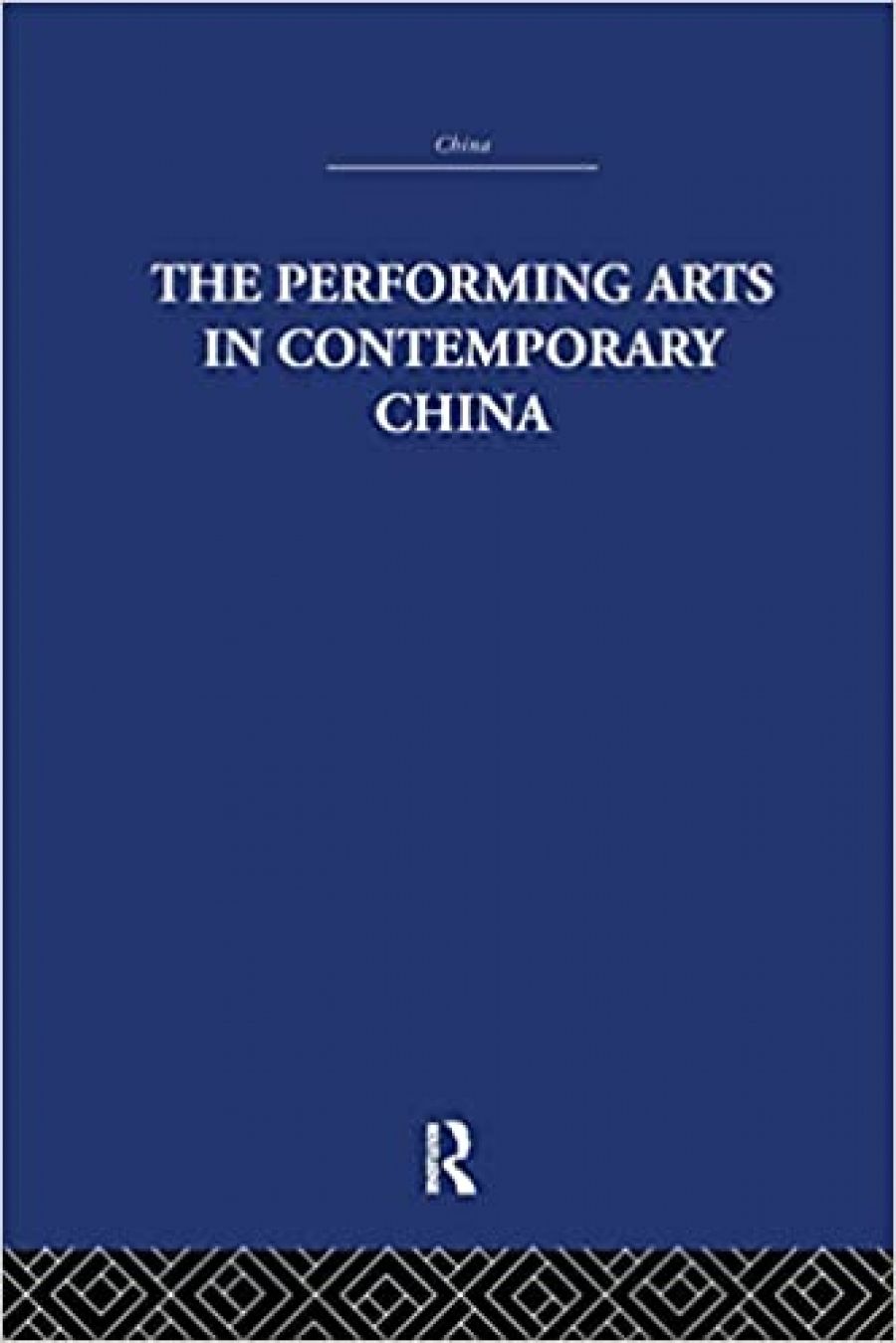
- Free Article: No
- Contents Category: Theatre
- Review Article: Yes
- Article Title: Theatre in contemporary China
- Online Only: No
- Custom Highlight Text:
Here is all you ever wanted to know about Chinese theatre and didn’t know whom to ask! Who better anywhere to ask than Professor Colin Mackerras? A distinguished sinologist, Chairman of the School of Modem Asian Studies at Griffith University, he speaks Chinese fluently, taught English in Shanghai from 1964–66, and has visited China regularly since then totting up a remarkable miscellany of visits – to theatres, academies, conservatoria, cinemas, commune, and factory performances and talks with dramatists, critics, composers and ‘the masses’.
- Book 1 Title: The Performing Arts in Contemporary China
- Book 1 Biblio: Routledge and Kegan Paul, 243 pp
Mackerras begins by putting today’s kaleidoscopic political scene in its recent historical context, well aware that in China more than in most countries the historical continuum is immensely significant. And this approach is, of course, essential when theatre, history and politics are all of a piece and aimed at defining a national identity after decades of revolutionary and post-revolutionary upheavals.
The book starts, then, with a survey of these upheavals from 1949–76 (with a few backward glances to the 1930s and 1940s): in the 1950s the Drama Reform Committee, the 100 Flowers Movement, the Anti-Rightist Campaign, the Great Leap Forward and, most startling of all, from 1966–76 the Great Proletarian Cultural Revolution leading to the reign of the so-called Gang of Four headed by Mao Zedong’s actress–wife, Jiang Qing.
Following Mackerras’s guiding thread we penetrate this cultural labyrinth where all performances reiterated doctrinal exhortations, beat, double forte, the political drum and banished the arts of foreign ‘barbarians’ from stage and screen. Particularly telling here, as elsewhere, are the carefully chosen quotations – Schubert’s Unfinished Symphony, for example, was ‘filled with petty-bourgeois despair and pessimism’ with the wrong ‘class feelings and social content’.
After a cogent analysis of cultural policy since Mao’s death, Mackerras considers the present position of both traditional and purely modem forms of the performing arts. Chapters three and four are especially valuable as they update, in more detail than any other account I know, the developments of the last few years, illustrating the pendulum-swing from the rigidities of the so-called ‘lost decade’ to the expansion of the ‘opening-up’, ‘the Second Liberation’. Especially noted is the return of Western performances Brecht’s Galileo, Much Ado About Nothing, American, European and British orchestras. Some titles of plays and operas are indeed memorable: Yue’s Mother Tattoos Characters, The Exchange of the Heir Apparent for a Leopard Cat and Going up Peach Peak Three Times.
Chapter three develops the theme of continuity amid change, the survival of traditional forms on today’s stage. The few pages summarising these, their content, style and music, offer an admirable exposition of a pretty complex topic.
Indeed, one of the book’s major qualities is the organisational and expository skill with which Mackerras handles his Herculean load of material. Consider, for example, some sections of the ‘Traditional Forms’ chapter – ‘Dramas about Past Rebellions’, ‘Dramas About Patriotic Resistance to Aggression’, ‘Dramas Based on Love Stories’, ‘About Monkey’, ‘Ballard and Storytelling Forms (Quyi)’.
From his own viewing Mackerras then illustrates modem forms per se, especially the blending of Eastern and Western cultures in sung opera (geju), dance-drama (wuju) and the two wholly Western forms, the film and the spoken play (huaju). But all these, too, are enmeshed, the author points out, in the political and social concerns of the Government. ‘We must choose topics’, stated a People’s Daily editorial, ‘according to the needs of implementing the four modernisations and the needs of the broad masses.’ So long as they keep this in mind ‘artists may write the things they are able and willing to write’. Mackerras is able and willing to write about film, analysing especially the treatment of violence and love themes. And about music.
As a Chinese theatre enthusiast, virtually uneducated in Asian music, I found this chapter pleasingly easy to understand.
The final chapter, rather quaintly called ‘Bringing Performances to Fruition’, brings us up-to-date on the choosing and training of performers, producers, designers and a whole bevy of theatre folk; salaries, health services, working hours, living conditions, nothing seems missing from the Mackerras compendium.
And so to the Conclusion – a drawing together of observations and impressions in a tentative effort to forecast where the performing arts will go from here. How best can China revive tradition, assimilate foreign culture, treat love and sex, magic and fantasy? How can the stage and screen provide instruction without boredom, nationalism without chauvinism, beat the political drum without drowning the rest of the orchestra?
At least, the problems are now being defined. Mackerras’s style is mercifully free from academic pretentiousness or specialist jargon thrown in pour épater le bourgeois. It is clear and readable though at times rather flat, even cumbersome.
Some of the illustrations from the author’s photographs have reproduced hazily, in contrast with the China Screen illustrations.
But these are minor flaws in the glass. This is a valuable book warmly recommended to China scholars, China watchers, theatre-buffs Eastern and Western, as well as those thousands of visitors whose guided tours include various samples of contemporary China’s performing arts.


Comments powered by CComment